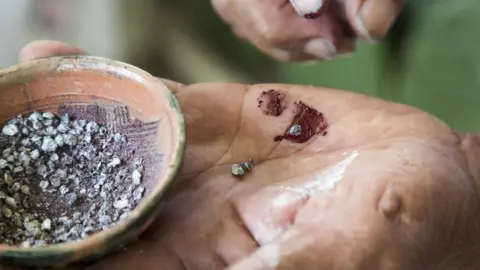Why you may have been eating insects your whole life
Business reporters, BBC News
 Helen Soteriou
Helen SoteriouIf you are horrified by the thought of eating insects, the bad news is that you have probably done so many, many times.
This is because one of the most widely used red food colourings - carmine - is made from crushed up bugs.
The insects used to make carmine are called cochineal, and are native to Latin America where they live on cacti.
Now farmed mainly in Peru, millions of the tiny insects are harvested every year to produce the colouring.
A staple of the global food industry, carmine is added to everything from yoghurts and ice creams, to fruit pies, soft drinks, cupcakes and donuts.
It is also used extensively in the cosmetics industry and is found in many lipsticks.
 MARK WILLIAMSON/SCIENCE PHOTO LIBRARY
MARK WILLIAMSON/SCIENCE PHOTO LIBRARYCarmine continues to be widely used because it is such a stable, safe and long-lasting additive whose colour is little affected by heat or light.
Supporters also point out that it is a natural product first discovered and used by the Maya and then the Aztecs more than five centuries ago. They claim that it is far healthier than artificial alternatives such as food colourings made from coal or petroleum by-products.
But even fans of carmine agree that it should be more clearly labelled, and there are a growing number of natural red colouring alternatives that don't come from insects.
Look for the word "carmine" on a food product that contains it, and you might not actually see it written in the list of ingredients.
Instead it might say "natural red four", "crimson lake" or just E120, to give carmine its European Union food additive classification number.
 Getty Images
Getty ImagesAmy Butler Greenfield, author of A Perfect Red, a book about carmine and its history, says that while she "feels strongly" that it should always be labelled, it is a natural product that has stood the test of time.
"Carmine is an incredibly stable and reliable natural food dye that can be used to create a wide range of colours - pinks, oranges, purples, as well as reds.
"A few people have serious allergic reactions to it, but overall it has a great, long-term safety record."
Peru now leads the way in production of carmine, and according to the Peruvian Embassy to the UK, the country has a 95% share of the international market.
This creates work for no less than 32,600 farmers, the embassy adds.
 JIM WEST/SCIENCE PHOTO LIBRARY
JIM WEST/SCIENCE PHOTO LIBRARYThe bugs, which are about 5mm or 0.2 inches long, are brushed off the pads of prickly pear cacti. It is the wingless females that are harvested, rather than the flying males.
The red colour comes from carminic acid, which makes up almost a quarter of the bugs' weight, and deters predation by other insects.
Ms Butler Greenfield says: "Generally the bugs are dried first... nowadays food-grade cochineal dye is put through many filters to remove insect parts."
Last year Peru exported 647 tonnes of carmine for a total value of $46.4m (£33m).
 Getty Images
Getty ImagesGiven what the dye is made from, you might think it would be a declining industry.
However, demand is rising and because the supply is finite - it is difficult for Peruvian farmers to substantially boost supplies - the price has soared in recent years.
Back in 2013 Peru's exports of carmine totalled 531 tonnes, which was worth $22m. So over the past four years, the price per tonne has risen by 73%.
UK-based Premier Foods, which owns brands including Mr Kipling cakes and Bachelor soups, continues to use carmine, but does consider switching to alternative colourings.
"We use carmine in some of our products, because it is natural and uniquely provides a particularly stable range of red and pink colours that do not fade," says a Premier Foods spokesman.
"[But] we continue to look for alternatives, which in addition to being natural, would also be suitable for vegetarians."
Animal rights group Peta would ideally like the use of carmine to be phased out all together.
"It reportedly takes up to 70,000 individual insects to produce just 500g of dye, so naturally, it's a product that compassionate consumers will want to avoid.
"Fortunately, the rapid growth in the number of people following a vegan lifestyle is encouraging more and more companies to develop animal-friendly products, so it's never been easier to choose vegan items for which no animal of any size has suffered."
One company that in recent years has moved away from carmine is US coffee shop giant Starbucks.
Back in 2012 customers complained after it was revealed that Starbucks used carmine in some of its iced coffees, smoothies and cakes. Starbucks responded by saying it would switch from carmine to lycopene, a natural, tomato-based extract.
Other natural food colouring alternatives include extracts from berries and beetroot. Yet none are as long-lasting and easy to use as carmine.
For example, betanin, the food colouring obtained from beetroots, degrades when exposed to light, heat and oxygen. It therefore typically only used in foodstuffs that have a short shelf life, or are frozen.
Ms Butler Greenfield says it is important to remember that carmine is a natural product that it is a vital source of income for poor farmers in Peru.
"People, mostly Peruvian, and mostly very poor, depend on carmine for their livelihood," she says.


No comments:
Post a Comment